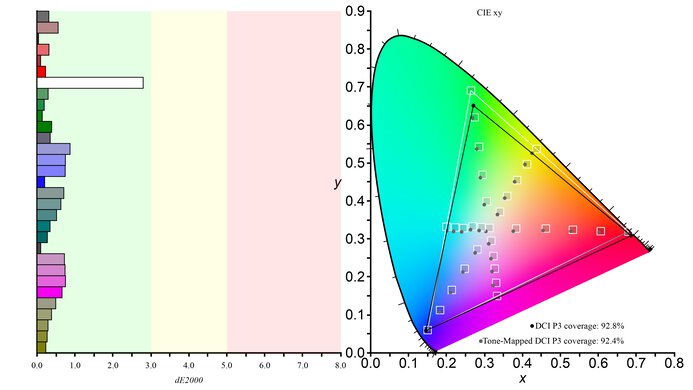The HP OMEN 27q is an entry-level, budget-friendly gaming monitor. With a 1440p resolution and 165Hz refresh rate, it's a newer monitor than the similar HP X27q, and it's a lower-end model than the HP OMEN 27qs, which has a 240Hz refresh rate. It includes FreeSync variable refresh rate (VRR) technology, but it's rather basic in terms of features as it lacks a USB hub, and only has two HDMI 2.0 ports and one DisplayPort 1.4 input. It also includes a 3.5mm audio jack, but other than that, it's barebones in extra perks.

We buy and test more than 30 monitors each year, with units that we buy completely on our own, without any cherry-picked units or samples. We put a lot into each unbiased, straight-to-the-point review, and there's a whole process from purchasing to publishing, involving multiple teams and people. We do more than just use the monitor for a week; we use specialized and custom tools to measure various aspects with objective data-based results. We also consider multiple factors before making any recommendations, including the monitor's cost, its performance against the competition, and whether or not it's easy to find.
Our Verdict
The HP OMEN 27q is good for most uses. It's designed as a gaming monitor with a 165Hz refresh rate, VRR support, low input lag for a responsive feel, and a fast response time at high refresh rates, but there's more blur at lower refresh rates. It has a 27-inch screen and 1440p resolution that help make it good for office use or content creation. It also has good text clarity and wide viewing angles, making it easy to share your screen. It's good if you want to use it in a bright room thanks to its good reflection handling and great peak brightness. However, it struggles in a dark room, like if you're watching a movie or show, as blacks look gray, and it doesn't have a local dimming feature to improve it.
- Good text clarity.
- Performs well in a bright room.
- Wide viewing angles.
- Stand offers tilt, height, and rotation adjustments.
- Doesn't offer swivel adjustment.
- No extra office features like a USB hub.
- Low contrast ratio.
The HP OMEN 27q is very good for the office. It has a 27-inch screen that's big enough to open two windows side-by-side, and it has high enough pixel density to have good text clarity. It's also good if you want to use it in a bright room as it gets bright enough to fight glare from most light sources, and it has good reflection handling. Its wide viewing angles are helpful if you need to share your screen with someone else, but without any swivel adjustment, it's hard to turn the screen. One downside is that it doesn't have many extra features, and there aren't any USB ports to connect your devices.
- Good text clarity.
- Performs well in a bright room.
- Wide viewing angles.
- Stand offers tilt, height, and rotation adjustments.
- Doesn't offer swivel adjustment.
- No extra office features like a USB hub.
The HP OMEN 27q is great for gaming. It has a 165Hz refresh rate with FreeSync VRR and G-SYNC compatibility to reduce screen tearing. It has a fast response time at high refresh rates and a backlight strobing feature to reduce persistence blur, but there's more motion blur at lower refresh rates. It has low input lag for a responsive feel at any refresh rate. Unfortunately, it doesn't have many extra gaming features as it's limited to HDMI 2.0 bandwidth, so it can't take full advantage of gaming consoles. It also has a low contrast ratio, so it's disappointing if you want to use it for gaming in dark rooms.
- 165Hz refresh rate.
- FreeSync VRR and G-SYNC compatibility.
- Fast response time at high refresh rates.
- Low input lag.
- Limited to HDMI 2.0 bandwidth; can't take advantage of gaming consoles.
- Low contrast ratio.
The HP OMEN 27q is satisfactory for media consumption. It's good if you want to watch content in a bright room, thanks to its good reflection handling and high peak brightness. It also has wide viewing angles that keep the image consistent from the sides, ideal for sharing your screen with a friend, but it doesn't have any swivel adjustment to easily turn it. Unfortunately, it's disappointing for watching content in dark rooms as it has a low contrast ratio that makes blacks look gray, and it lacks a local dimming feature to improve the black levels.
- Performs well in a bright room.
- Wide viewing angles.
- Low contrast ratio.
- No local dimming feature.
The HP OMEN 27q is very good for content creation. Its 1440p resolution delivers enough details while editing your photos, and the monitor has good image clarity as well. It also has excellent accuracy in any of the picture modes that use an sRGB clamp, but while it displays a wide range of colors, some are oversaturated. It also has wide viewing angles that are ideal if you need to share your screen with a coworker or client, as the image remains consistent from the sides, but it doesn't offer any swivel adjustment to turn the screen.
- Good text clarity.
- Performs well in a bright room.
- Wide viewing angles.
- Excellent accuracy before calibration.
- Doesn't offer swivel adjustment.
- No extra office features like a USB hub.
The HP OMEN 27q is mediocre for HDR. It has a very basic implementation of HDR, as there aren't any picture modes or settings available, and it doesn't get bright enough to make highlights stand out. While it displays a wide range of colors, it has limited color volume, so most colors aren't vivid. Lastly, blacks look gray in the dark due to the low contrast, and it doesn't have a local dimming feature to improve the contrast either.
- Displays wide range of colors.
- Low contrast ratio.
- No local dimming feature.
- Low HDR peak brightness.
- Minimal settings available in HDR.
Check Price
Differences Between Sizes And Variants
We tested the 27-inch HP OMEN 27q, and units of it are made with panels from two different manufacturers, LG and BOE, and our unit features an LG panel. It's also available as the 32-inch HP OMEN 32q, but the results are only valid for this monitor. It's part of the OMEN gaming lineup, which includes similar models that have a few different features, and you can see the differences between them below.
| Model | Size | Panel Type | Resolution | Max Refresh Rate |
|---|---|---|---|---|
| 27q | 27" | IPS | 1440p | 165Hz |
| 32q | 32" | IPS | 1440p | 165Hz |
| 27qs | 27" | IPS | 1440p | 240Hz |
Our unit was manufactured in April 2023, and the Rev. number is L0IT1121; you can see the label here. We tested this monitor with firmware 1.20.1.0.
Popular Monitor Comparisons
The HP OMEN 27q is a great gaming monitor that offers the essentials for gaming, like a 165Hz refresh rate, VRR support, low input lag, and a fast response time at high refresh rates. The 1440p resolution is also a nice touch if you like seeing details in your games. While it's great for what it offers, especially at a low cost, you can get better value with other budget-friendly monitors like the Dell G2724D, which has better motion handling, and the Gigabyte M27Q P, which has extra features that make it more versatile.
See our recommendations for the best gaming monitors under $300, the best budget and cheap gaming monitors, and the best 1440p gaming monitors.
The HP OMEN 27q is a newer monitor than the HP X27q, and they have many similarities, including their 1440p resolution and 165Hz refresh rate. There are some differences, as the 27q has an sRGB picture mode, which the X27q doesn't have, allowing better accuracy before calibration. The 27q also displays a wider range of HDR colors, but both monitors have limited HDR performance anyway. In terms of gaming, the 27q has better motion handling at high refresh rates, but there aren't many differences besides that.
The HP OMEN 27qs is a higher-end monitor than the HP OMEN 27q, so it has a few extra features. The main difference is that the 27qs has a higher 240Hz refresh rate and better motion handling across its entire refresh rate range. The 27qs also has some extra perks, like a USB hub, and it has a local dimming feature, but it performs terribly anyway.
The HP OMEN 27q and the Samsung Odyssey G50D S27DG50 are both entry-level 1440p gaming monitors. Besides the Samsung model having a slightly higher refresh rate, both monitors are similar. The Samsung comes with a more ergonomic stand as it can swivel, which the stand on the HP can't do. The Samsung monitor also has a local dimming feature, but it doesn't add much because it performs so similarly.
The HP OMEN 27q and the Gigabyte G27Q are both great budget-friendly 1440p gaming monitors. The HP has a slightly higher 165Hz refresh rate and better motion handling, leading to less blur. The Gigabyte is better for console gaming because it can downscale 4k signals from the PS5 and Xbox Series X|S, which the HP monitor can't do. On top of that, the Gigabyte has a few extra features, like a USB hub.
Test Results

The build quality is good. The plastic materials feel good, and there aren't any obvious issues. The one downside is that the base of the stand doesn't keep the monitor in place, meaning it easily moves on the table. So, if you try adjusting the screen, everything moves, but this isn't an issue unless you're constantly playing around with the placement of the screen.
The ergonomics are good. It's easy to adjust the screen when you're sitting directly in front of it, but without swivel adjustment, it's hard to turn the screen to show it to someone next to you. At the height adjustment's lowest setting, the top of the screen is 16.7" (42.4 cm) from the desk. The back of the monitor features matte plastic and the stand has a clip for cable management.
The HP OMEN 27q has a low contrast ratio, so blacks look gray next to bright highlights, and it doesn't have a local dimming feature to further improve it. If you care about better contrast, check out the Samsung Odyssey G5/G55C S27CG55.
This monitor doesn't have a local dimming feature. We still film these videos on the monitor so you can compare the backlight performance with a monitor that has local dimming.
The SDR brightness is great. It gets bright enough to fight glare and maintains this high peak brightness no matter the content, which is great. These results are from after calibration in the 'Gaming' Color Mode with the Brightness at its max.
The HDR peak brightness is decent. While it gets fairly bright, small highlights don't pop against the rest of the image as it lacks a local dimming feature. The EOTF also has a slow roll-off at the peak brightness, so it doesn't let highlights get the brightest they could before reaching their peak brightness. Unfortunately, no picture settings are available when you enable HDR, so it's a very basic implementation of HDR.
The HP OMEN 27q has an impressive horizontal viewing angle. You won't notice any issues when viewing from the sides or if you need to share your screen with someone next to you.
The vertical viewing angle is okay. Although it's worse than its horizontal viewing angle, you won't have many issues, and the image only starts to appear washed out when you're standing up and looking down directly at the monitor.
The HP OMEN 27q has excellent accuracy before calibration. While it doesn't have a dedicated sRGB mode, many of the Color Modes include an sRGB clamp, which are the 'HP Enhance +', 'Standard', 'Warm', 'Cool', 'Cinema', and 'Night' modes. These modes lock colors well to the sRGB color space, so most colors are accurate. The white balance is decent, but brighter grays are off, and gamma doesn't follow the target sRGB well, as most scenes are too bright. Unfortunately, the color temperature is on the cold side, giving the image a blue tint.
When using one of the modes that include the sRGB clamp, you still have access to other picture settings. Only the 'Gaming' and 'Native' modes don't use the sRGB clamp, and the main advantage to using those is that they get brighter. The 'Gaming' mode is the more accurate of the two, but colors are oversaturated, as you can see here.
The accuracy after calibration is excellent. While it isn't significantly different than using the 'HP Enhance +' mode before calibration, one of the advantages of calibrating it is that you get a brighter image while maintaining accuracy.
The HP OMEN 27q has a fantastic SDR color gamut, but it's oversaturated in the commonly used sRGB color space. Reds and magentas are also oversaturated in the Adobe RGB color space, but blues and greens are undersaturated there.
The HDR color gamut is excellent. It has excellent coverage of the DCI-P3 color space used in most HDR content, with remarkable tone mapping. However, it has worse coverage of the wider Rec. 2020 color space, and tone mapping is a bit worse with it, too, particularly with white, cyan, and green.
The reflection handling is good. Combined with its high peak brightness, you won't have issues using it in a well-lit room, but glare from strong light sources is distracting, like if you place it opposite a sunny window.
The HP OMEN 27q has good text clarity. Enabling Windows ClearType (top photo) improves the clarity of most letters. These photos are in Windows 10, and you can see them in Windows 11 with ClearType on and with ClearType off.
Due to bandwidth limitations over HDMI, you can only reach this monitor's max refresh rate over DisplayPort.
Both FreeSync and G-SYNC compatibility work over the monitor's entire refresh rate range via DisplayPort, but only FreeSync works via HDMI. The monitor also supports Low Framerate Compensation (LFC) for the VRR to continue working at lower refresh rates, and it kicks in around 60Hz.
| Overdrive Setting | Response Time Chart | Response Time Tables | Motion Blur Photo |
| Level 1 | Chart | Table | Photo |
| Level 2 | Chart | Table | Photo |
| Level 3 | Chart | Table | Photo |
| Level 4 | Chart | Table | Photo |
| Level 5 | Chart | Table | Photo |
The response time at the max refresh rate of 165Hz is excellent. Most transitions are fast, leading to minimal motion handling, and there isn't any noticeable overshoot either. While the recommended Response Time of 'Level 3' has a slower total response time than 'Level 2', it has a faster rise/fall time, and there's less blur trail behind fast-moving objects. The 'Level 4' and 'Level 5' settings have too much overshoot.
| Overdrive Setting | Response Time Chart | Response Time Tables | Motion Blur Photo |
| Level 1 | Chart | Table | Photo |
| Level 2 | Chart | Table | Photo |
| Level 3 | Chart | Table | Photo |
| Level 4 | Chart | Table | Photo |
| Level 5 | Chart | Table | Photo |
The HP OMEN 27q QHD 165Hz Gaming Monitor has an excellent response time at 120Hz. Unlike at its max refresh rate, the recommended overdrive setting is 'Level 2' because 'Level 3' has more noticeable overshoot, leading to inverse ghosting. The 'Level 2' setting results in minimal motion blur.
| Overdrive Setting | Response Time Chart | Response Time Tables | Motion Blur Photo |
| Level 1 | Chart | Table | Photo |
| Level 2 | Chart | Table | Photo |
| Level 3 | Chart | Table | Photo |
| Level 4 | Chart | Table | Photo |
| Level 5 | Chart | Table | Photo |
The response time at 60Hz is decent. There's some motion blur with fast-moving objects, but the recommended overdrive setting of 'Level 1' has no overshoot, unlike the higher settings, which all have it. This means you may need to change the Response Time setting depending on the refresh rate you're gaming at, but 'Level 2' is a good enough set-and-forget mode with any refresh rate. That said, this monitor's LFC feature kicks in at 60Hz, doubling the refresh rate to 120Hz when you have VRR enabled, so you only get a true 60Hz refresh rate with VRR disabled.
| Overdrive Setting | 165Hz | 120Hz |
| 1 |  |
 |
| 2 |  |
 |
| 3 |  |
 |
| 4 |  |
 |
| 5 |  |
 |
The HP OMEN 27q QHD has an optional backlight strobing feature, commonly known as black frame insertion. You need to turn off Adaptive Sync to use the MPRT setting, which has five different options, with '5' being the most aggressive, but it also results in the lowest brightness. The feature does a decent job at reducing persistence blur at its max refresh rate, but it also has image duplication, and the differences between the five options are minimal, as you can see here.
The HP OMEN 27q has low input lag for a responsive feel, which doesn't significantly increase at high refresh rates.
The HP OMEN 27q can't take full advantage of the PS5 as it's limited to HDMI 2.0 bandwidth, doesn't support VRR, and can't downscale 4k signals. That said, there aren't any compatibility issues with the signals it supports.
This monitor has limited compatibility with the Xbox Series X|S. It doesn't support HDMI 2.1 bandwidth to fully utilize the console. HDR doesn't work either, as the console only supports HDR with 4k signals, which the monitor doesn't accept.
This monitor doesn't have any USB ports. If you're looking for a gaming monitor that has USB ports, check out the MSI G274QPF-QD.
The HP OMEN 27q QHD works well with macOS using a DisplayPort to USB-C cable. VRR and HDR work at the same time, and while HDR looks washed out, this is a limitation of the monitor anyway. If you're using a MacBook, windows return to the original position when waking up the laptop from sleep, but not when you close the lid.
The HP OMEN 27q QHD 165Hz Gaming Monitor has a few extra features, including:
- Crosshair: You can choose different virtual crosshairs available, giving you a competitive advantage as your game's anti-cheat tool won't detect it.
- Diagnostic Patterns: Displays full-screen images of different colors so you can see any uniformity issues or dead pixels more easily.
- Frame Rate: Displays the current frame rate from your source.
- Multi-Monitor Align: Makes it easier to align the monitor next to another by displaying an overlay.
- OMEN Gaming Hub: This monitor works with HP's proprietary app to change certain settings, even if it doesn't have a USB hub to connect your PC to.





















































